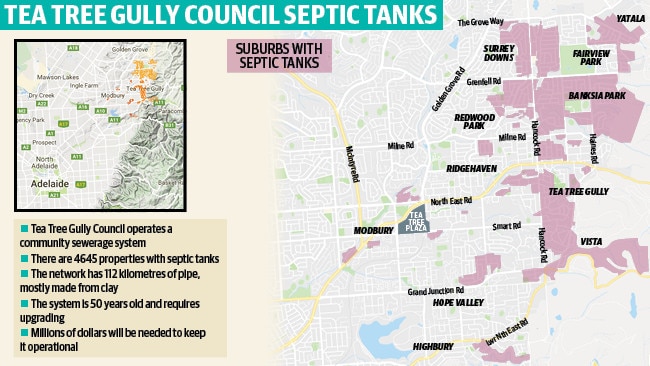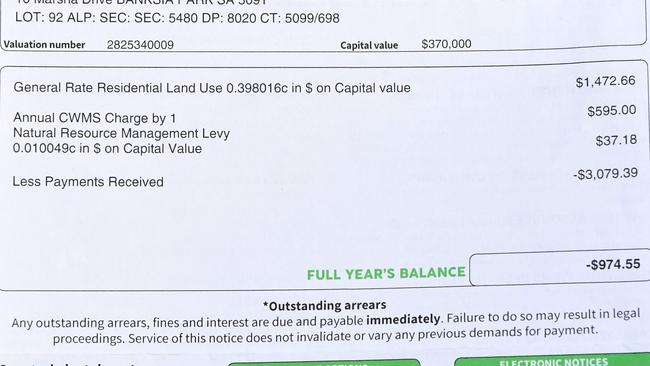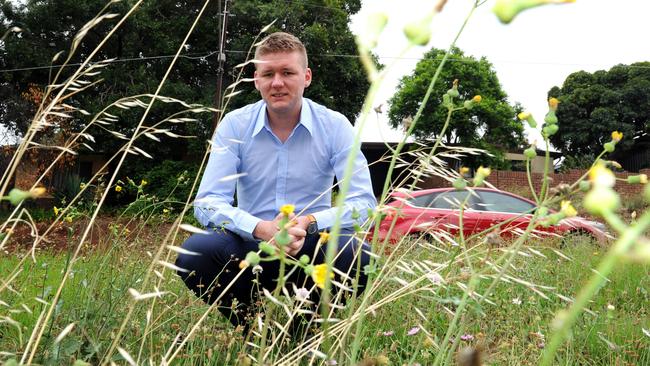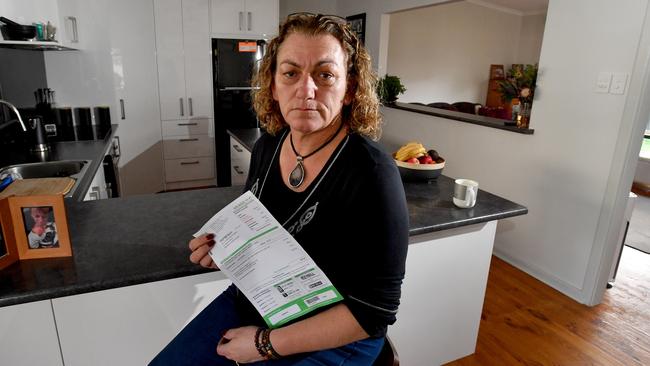Tea Tree Gully Council must spend millions on Community Wastewater Management System
UPDATED: THOUSANDS of ratepayers could face higher charges for septic tanks in metropolitan Adelaide if their council cannot secure government funding for urgent upgrades.

THOUSANDS of ratepayers could be hit with higher charges if State Government funding cannot be secured to upgrade a community wastewater system in northeastern Adelaide.
A report prepared by Tea Tree Gully Council has identified serious problems with its Community Wastewater Management System (CWMS) which operates 4645 septic tanks and 112km of pipes.
Suburbs covered by the 50-year-old system include Banksia Park, Tea Tree Gully, Redwood Park, Ridgehaven, Vista, Fairview Park, Yatala Vale, Surrey Downs, St Agnes, Hope Valley, Modbury North and Modbury.

The system takes liquid effluent through pipes to junctions with SA Water’s mains system while solids remain in the septic tanks. They are cleaned every four to five years by council contractors.
Council crews are increasingly responding to reports of clay pipes cracking, blockages and spillages of raw sewage. The annual fee for a septic tank recently has been increased by $20 to $595. It is levied on top of annual rates.
Councillors have been privately briefed by staff on the potential costs of overdue maintenance and required upgrades for the CMWS, which will escalate as it becomes older and put under more pressure by urban infill.
They have been presented with two scenarios, projecting annual costs of $1.93 million or $2.68 million for the next decade. External funding will be sought to help ease the financial burden on the council.
An asset management report tabled at a recent council meeting said there were numerous risks if the money was not spent on the system.
These included:
RISKS to public health and environmental pollution, particularly groundwater contamination, due to “leaking assets and privately owned septic tanks”.
FAILURE of “critical assets such as trunk mains, disrupting services over extended periods”.
POOR understanding of buried assets “leading to poor planning of asset renewals”.
INCREASING urban infill “placing increased demand on the CWMS network”.
The report said there would be an adverse financial impact on council if the system was not adequately maintained or upgraded.
Customers could experience “financial hardship due to poor forward planning, leading to unexpected large increases in rates to fund urgent rehabilitation”.
“The asset sustainability analysis indicates that assets are wearing out faster than they are renewed and that the current CWMS expenditure in the LTFP (long term financial plan) is not sustainable and requires an increase to reduce the risk of complete asset failures,” says the report.
Blockages had increased by 138 per cent over the past five years and would get worse “unless more capital expenditure is made available to renew and upgrade assets that have reached or are close to the end of their useful life”.
The failure to maintain or upgrade the CWMS also would adversely impact on development which could “slow down or end in some areas due to decreasing network capacity”.
Council had started a monitoring program to plan for future growth and development in areas serviced by the system “to ensure that infrastructure is in place to cater for current and future demand”.
The report warned the CWMS was built between 1962 and 1970, with vitrified clay pipes forming most the networks. These were susceptible to cracking, especially within reactive soil.

The network was coming under strain as more housing development continued to occur in Adelaide’s northeast.
“Although the CWMS system had provided enormous benefits at the time of installation, it was not designed to cope with the high density living now witnessed in our city,” says the report.
Demand for the system had increased dramatically in recent years, with council annually receiving an average of 57 wastewater applications between 2012 to 2016. In 2017, it received 94.
High growth areas included Modbury, Modbury North, St Agnes and Ridgehaven.
“There are currently a total of 949 existing CWMS customers in these high growth suburbs,” says the report.
“This means approximately 20 per cent of the total number of CWMS customers are living in areas that are likely to experience a greater growth than other CWMS serviced areas.”
The report recommends funding for the system needs to be increased in the short term to alleviate the problems already being experienced. The current infrastructure backlog was estimated to be $3.8 million.
It says a funding strategy needs to be developed for a capital works program, especially for the renewal of assets.
This included “charging for service that ensures full cost recovery of assets and taking into consideration appropriate charging for cost of risk of the scheme”.
The report also called on council to apply for grants to help pay for the maintenance and upgrading of the CWMS.
“Council has not been charging for CWMS to achieve full cost recovery of assets and has limited reserves to undertake emergency rehabilitation,” it says.
“Council will currently have to rely on borrowings to undertake rehabilitation work.”
Council organisational services and excellence director Ryan McMahon said it was waiting on the outcome of an application for a $15 million Regional Growth Fund grant.
Council staff also had met with local politicians, including new Liberal MP Richard Harvey, to seek further funding support.
Mr McMahon said changes to the CWMS annual charge would be determined as part of the development of council’s annual budget.

RATEPAYERS SHOULDN’T BE LIABLE FOR ‘ARCHAIC SYSTEM’
A TEA TREE GULLY councillor wants millions of dollars in state or federal funding to help upgrade an ageing community sewerage system.
Deputy Mayor Lucas Jones has asked the council to seek external support, saying ratepayers should not be left with the financial burden of running more than 4750 septic tanks on the northeastern edge of Adelaide.
“It is hard to comprehend that in 2018 there are still over 4500 properties in the middle of suburbia on an archaic waste system,” he said.
“My house in the suburb of Tea Tree Gully is on the CWMS network, and so are all my neighbours, and I know from speaking to them that many houses in the area are having to regularly call out council because of cracked piping and leaking sewage. The system belongs in the archaic times, not 2018.”
Cr Jones said a detailed report by council staff had clearly stated the Community Wastewater Management System (CWMS) needed millions of dollars for overdue maintenance and upgrading for decades to come.
“The network needs upgrading, that isn’t disputable,” he said.
“What I don’t want to see happen though are my residents being slugged hundreds of dollars extra to fund the upgrade when essentially the waste water system is a State Government responsibility and it’s high time this system is upgraded.”
Cr Jones said the council had a duty to ensure residents were aware of the upgrades needed to the system, which is the largest of its kind in SA.
“Residents shouldn’t be hit with bill shock down the track because the State Government hasn’t come to the party and assisted residents in upgrading the system,” he said.
Cr Jones said he was strongly opposed to any type of privatisation of the CWMS network and would “do everything in my power to stop it from happening”.

RESIDENT DOESN’T WANT TO BE DUMPED WITH BILL
ROSE Morton is one of 4645 ratepayers paying $595 each year for a septic tank on the northeastern edge of Adelaide.
The Banksia Park resident says a community sewerage system operated by Tea Tree Gully Council is causing widespread problems, with regular blockages, broken pipes and spillages of raw sewage.
Ms Morton says SA Water or a private contractor should take over the Community Wastewater Management System (CWMS) to avoid ratepayers paying millions for maintenance and upgrades.
“The system was only ever meant to be temporary when this area was first being developed fifty years ago,” she said.
“It was never meant to be sustain what it has to do today.
“Blocks are getting smaller and smaller and they are accommodating more and more people who need toilets.
“The system already can’t cope and it’s just going to keep getting worse.”
Ms Morton said Tea Tree Gully Council had to become more proactive about informing the community about the problems facing the system.
“They just bury it all in some report which nobody’s going to read. They need to tell us what is going on.”
